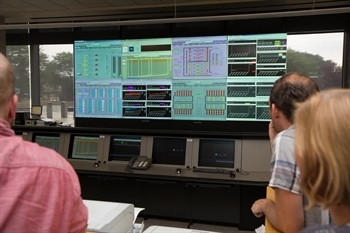
Ryan Griffin-Stegink
The Stickney Water Reclamation Plant treats wastewater on its way to the Gulf of Mexico.
Have you ever wondered what happens after you flush the toilet in the morning? If you’re like me, for most of your life you really didn’t give it much thought. But in late August MPC staff, along with our partners from the Metropolitan Mayors Caucus and the Grand Victoria Foundation, got a behind-the-scenes tour of the Metropolitan Water Reclamation District of Greater Chicago’s (MWRD) facilities.
MWRD is responsible for treating and discharging wastewater—both residential and industrial. On the journey from my bathroom to the Chicago River, MWRD is an intermediate stop where the water is cleaned before moving on to its final destination in the Gulf of Mexico. But that’s only half the story. MWRD is also responsible for supervising and managing stormwater. During our tour, led by MWRD’s Stephen Carmody, Kevin Fitzpatrick, Ahmad Laban and Bill White, we got inside information on the inventive techniques the facility is using to stay up-to-date on sustainability and reuse trends.

First stop: MWRD's control room.
Ryan Griffin-Stegink
Our first stop was the central control room where the water levels in pipes and tunnels are monitored. It was raining outside, so we were able to see in real time how they track rain events while also monitoring the capacity of their reservoirs. Seeing the command center was helpful for understanding the rest of the facilities we would see on the tour.
The next stop was primary and secondary treatment at the Stickney Water Reclamation Plant. This is where a lot of the settling of solids occurs. Yes, your solids and my solids. As you can imagine, the smell was quite strong.

Primary treatment: What's that smell?
Ryan Griffin-Stegink
But, MWRD has a way to turn these biosolids into something incredibly useful—fertilizer! These wastes are trucked over to huge drying fields and laid out to cure in the sun. After drying to the appropriate water concentration, this organic fertilizer is provided to local farmers, municipalities and nurseries. It’s pretty amazing that something we view as a waste can be re-used and turned into an asset.
Our final stop took us to the McCook Quarry, the site of a future reservoir that is currently under construction. This reservoir is part of MWRD’s strategy to reduce combined sewer overflows (CSOs). Combined sewers, receiving water from both residential and industrial drains as well as outside sewers, can become overwhelmed during major storms resulting in untreated wastewater getting flushed into bodies of water, like our own near and dear Lake Michigan.

The immense McCook Quarry.
Ryan Griffin-Stegink
The McCook Quarry is part of the Tunnel and Reservoir Plan (TARP), which consists of a series of deep tunnels and large reservoirs that will capture and store water during these intense rain events. This reservoir is scheduled to come on-line in 2029, as the largest CSO reservoir in the country.
TARP is only part of the solution to increasing the capacity of the system to hold water. MWRD is also piloting the use of green infrastructure as a flood control tactic on MWRD property. By using vegetation and porous materials to manage rain where it falls, MWRD is working to keep stormwater out of both the sewers and reservoirs, thereby increasing the storage potential of the entire system.
MWRD has tremendous reach, serving an area of 883 square miles, including the City of Chicago and 125 suburban communities, and great potential to positively impact the region with its forward-thinking policies and initiatives. Some exciting opportunities are taking root at MWRD and this visit has taught me not only what happens after I flush, but also how integrated, closed loop problem-solving can help our region comprehensively tackle some of our shared water management obstacles.